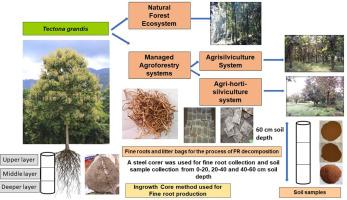Variations in fine root dynamics of Tectona grandis among natural and managed systems of Central Himalaya, India
IF 2.9
Q1 FORESTRY
引用次数: 0
Abstract
Tree fine roots contribute to manage the microclimate of soil through regulating the physico-chemical and biological attributes within an ecosystem. Present research was confined with fine root dynamics of Tectona grandis in the three sites include, one natural forest and two managed agroforestry systems of Central Himalaya, India with the aim to analyse the relationship between soil and fine root parameters to assess the temporal growth pattern in fine root parameters and to depict the vertical distribution and annual variation of fine roots under natural versus artificial systems. This research work was conducted during the year 2020 to 2022. Sequential core method was used for the estimation of biomass while, ingrowth core method for the production of fine root. Seasonal sampling of fine roots was done up to the three soil depths, i.e., 0–20 cm, 20–40 cm and 40–60 cm in triplicates. Sand, silt, pH were negatively correlated (p < 0.05) while, clay, water holding capacity, soil organic carbon and total nitrogen showed positive correlation (p < 0.05) with fine roots. Various traits of fine root were observed higher in natural system as compared to the managed systems. Rainy season was the most suitable period for the production of fine roots while, summer was least favourable. Soil profundity was inversely correlated with fine root traits. Greater carbon was recorded in the natural system (2.74 %) as compared to the managed systems (1.14 %) but nutrient uptake was observed higher in managed systems (37.50 %) than the natural system (34.21 %). Fine roots were significantly affected by land use forms, seasons and soil profundity.

印度喜马拉雅中部自然系统和人工系统中大构造细根动态的变化
树木细根通过调节生态系统内的物理化学和生物属性,有助于管理土壤的小气候。本研究以印度喜马拉雅中部3个地点(1个天然林和2个农林业管理系统)的大地构造(Tectona grandis)细根动态为研究对象,分析土壤与细根参数之间的关系,评价细根参数的时间变化规律,描绘自然与人工系统下细根的垂直分布和年变化。这项研究工作在2020年至2022年期间进行。生物量采用序贯核法估算,细根产量采用长入核法估算。在0 ~ 20 cm、20 ~ 40 cm和40 ~ 60 cm 3个土层深度进行细根季节性取样。砂、粉、pH与细根呈负相关(p < 0.05),粘土、持水量、土壤有机碳、全氮与细根呈正相关(p < 0.05)。自然系统的细根各项性状均高于人工管理系统。雨季最适宜细根生长,夏季最不适宜细根生长。土壤深度与细根性状呈负相关。自然系统的碳含量(2.74%)高于管理系统(1.14%),但管理系统的养分吸收量(37.50%)高于自然系统(34.21%)。细根受土地利用方式、季节和土壤深度的影响显著。
本文章由计算机程序翻译,如有差异,请以英文原文为准。
求助全文
约1分钟内获得全文
求助全文
来源期刊

Trees, Forests and People
Economics, Econometrics and Finance-Economics, Econometrics and Finance (miscellaneous)
CiteScore
4.30
自引率
7.40%
发文量
172
审稿时长
56 days
 求助内容:
求助内容: 应助结果提醒方式:
应助结果提醒方式:


